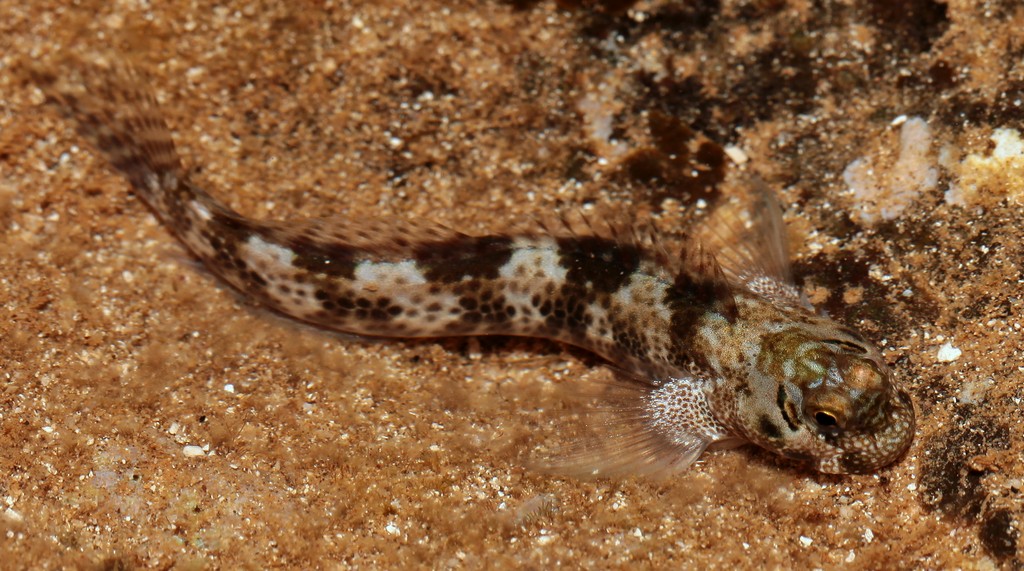ENTOMACRODUS STRIATUS - (VALENCIENNES, 1836)
Actinopterygii (Gigaclass) > Actinopteri (Class) > Teleostei (Subclass) > Blenniiformes (Order) > Blennioidei (Suborder) > Blenniidae (Family) > Salariinae (Subfamily) > Entomacrodus (Genus)
Black-spotted rockskipper, Blackspotted rockskipper, Pearly rockskipper, Reef margin blenny, Streaked blenny, Striated blenny, Pêrel-klipspringer, Sujiginpo, スジギンポ, 横带间颈须鳚, 橫帶間頸鬚鳚,
Synonymes
Entomacrodes striatus (Valenciennes, 1836)
Entomacrodus plurifilis marshallensis (Schultz & Chapman, 1960)
Entomacrodus plurifilis plurifilis (Schultz & Chapman, 1960)
Entomacrodus wolffi (Rofen, 1958)
Salarias arenatus (Bleeker, 1855)
Salarias fraenatus (Valenciennes, 1836)
Salarias froenatus (Valenciennes, 1836)
Salarias striatus (Valenciennes, 1836)
---------------------------
Description
Dorsal spines (total): 12-14 (usually: 13); Dorsal soft rays (total): 14-17; Anal spines: 2; Anal soft rays: 15-18; Pectoral fin rays: 13-14; Pelvic fin rays: I, 4. Body elongated, slightly flattened, cylindrical; Head bluntly short. Head without membranes, nasal beard palmately branched, eye upper beard pinnately branched, neck unbranched. Nape usually with 1 cirrus on each side (rarely absent); Supraorbital cirri: 1-20 on each side. Free margin of upper lip entirely crenulate (crenulae sometimes weakly developed). Preopercular pore positions each with 1 pore. Dorsal fin with deep notch, last spine small, dorsal fin attached to caudal stalk, anal fin not attached to caudal stalk, first spine of anal fin buried in germinal valve in female; Caudal fin forked. Max. length: 11.0 cm TL. Depth range: 0 - 5 m.
Color
Male: oblique lines behind eyes, brown band on upper lip, Λ-shaped pattern on lower head, band of five black spots on sides of body, central gray spot on side of body; Dorsal fin with brown spots; Anal fin grayish-black, deeper rim; Caudal fin with 5-6 horizontal brown bands.
Female: same as male but with brown spots on head except on lower part of head; Upper lip without band; Anal fin pale.
Etymology
Entomacrodus: from Greek, ento = inside, in + from Greek, makros = big + from Greek, odous = teeth. Referring to very large and recurved tooth on each side of interior lower jaw of Entomacrodus nigricans and/or to its “greatly developed” canine teeth.
striatus: from Latin, striatus = channel, groove or furrow. Referring to “eight gray vertical lines, bordered with blackish” on the front of the muzzle, with three more under the throat, “forming chevrons, as in many blennies and clinids”.
Original description: Salarias striatus Valenciennes, 1836 - Type locality: Mauritius, Mascarenes, southwestern Indian Ocean.
Distribution
Red Sea; Indo-West Pacific: KwaZulu-Natal (South Africa), East Africa (Mozambique, Tanzania, Kenya), Seychelles, Comoros, Madagascar and Mascarenes (La Réunion, Mauritius, Rodrigues), east to Wake Atoll and Pitcairn Group, north to southern Japan, south to Rottnest Island (Western Australia), Coral Sea (Queensland, Australia), Lord Howe Island (Australia), New Caledonia and Rapa (French Polynesia).
Biology
Adults occur in the intertidal zone of lagoons and wave-swept seaward reefs. They inhabit holes of limestone matrix at low tide. At low tide they may be found in small pockets of water left in pitted limestone. Oviparous. Eggs are demersal and adhesive, and are attached to the substrate via a filamentous, adhesive pad or pedestal. Larvae are planktonic, often found in shallow, coastal waters.
Similar species
Blenniella chrysospilos (Bleeker 1857) - Reported from New Caledonia. Link to the species (here).
Blenniella chrysospilos (Bleeker 1857) - Reported from New Caledonia. Link to the species (here).
Blenniella paula (Bryan & Herre, 1903) - Reported from New Caledonia.
Blenniella periophthalmus (Valenciennes, 1836) - Reported from New Caledonia.
Entomacrodus caudofasciatus (Regan, 1909) - Reported from New Caledonia. Link to the species (here).
Blenniella periophthalmus (Valenciennes, 1836) - Reported from New Caledonia.
Entomacrodus caudofasciatus (Regan, 1909) - Reported from New Caledonia. Link to the species (here).
Last update: 13, May 2023
